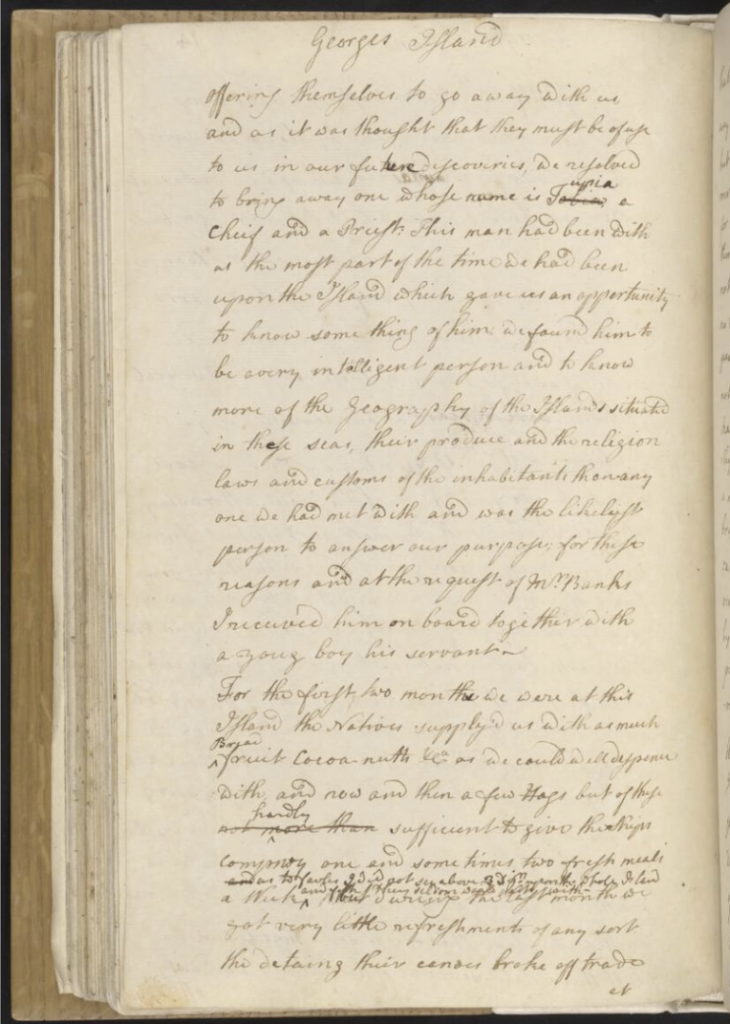by Chavella Kauhane Espinosa-Ramos (B.A. Political Science, Current MEdT Student)
Raʻiātea

Aloha kākou! Our huakaʻi brought us to Raiatea today, and it has been nothing short of inspiring. Day 4 of our Hawaiian Youths Abroad was dedicated to the legacy of Tupaia1, the renowned navigator and arioi who played a pivotal role in bridging the Pacific Ocean’s vast expanse with the West.
Tupaia2, born around the mid 1720ʻs on the island of Raiatea in the Society Islands, was a highly skilled Polynesian navigator. He hailed from a lineage of esteemed navigators and was trained in the traditional art of wayfinding, which included reading the stars, ocean swells, and other natural signs to navigate the vast Pacific.
James Cook3, a British explorer and cartographer, embarked on his first voyage on the HMS Endeavor with the main goal of observing the transit of Venus across the Sun, but he also aimed to seek the hypothetical southern continent, Terra Australis. The Endeavor reached Tahiti in 1769, where Cook and his crew met Tupaia. With Tupaia’s profound navigational skills, Cook was forced to take Tupaia aboard the ship with him.
Tupaia’s role aboard the Endeavor was invaluable. He served not only as a guide and interpreter but also as a cultural intermediary between the Europeans and the Polynesians. His knowledge enabled Cook to navigate the complex network of islands in the Pacific with greater accuracy4. Tupaia created detailed maps from memory, which depicted the locations of various islands across the South Pacific. These maps were astoundingly precise, and they greatly enhanced the European understanding of the region’s geography.
The partnership between Tupaia and Cook had a lasting impact on the field of navigation and cartography. It demonstrated that there can be value in integrating indigenous knowledge with European scientific methods. Tupaia’s contributions has shown the advanced navigational systems developed by Polynesians, which had enabled them to explore and settle across the vast Pacific Ocean long before European explorers even thought to.
The Endeavor’s voyage and the maps produced from it provided a foundation for future exploration and understanding of the Pacific. They opened new routes for trade, scientific research, and further colonization. However, this period of exploration also marked the beginning of significant cultural disruptions and challenges for indigenous populations due to increased European contact.

In spite of these challenges traditional ways of navigation have endured. The Hokulea, played a pivotal role in reviving and demonstrating the viability of polynesian navigation methods. Launched in 1975 by the Polynesian Voyaging Society, the Hokulea was built to celebrate and preserve the ancient voyaging traditions of Polynesia. The canoe’s name, meaning “Star of Gladness,” symbolizes the navigational star Arcturus, which rises above Hawaii and was historically used by Polynesian navigators.
The most significant of Hokulea’s5 voyages was its 1976 journey from Hawaii to Tahiti, led by navigator Mau Piailug from the Micronesian island of Satawal6. Piailug navigated the 2,500-mile solely on traditional methods. This successful journey not only validated the accuracy and reliability of Polynesian navigation techniques but also ignited a cultural renaissance among Hawaiians and other Pacific Islanders.
The 1976 Hokulea7 voyage to Tahiti served to reconnect Hawaii with one of its ancestral homelands, symbolizing the deep-rooted connections between Polynesian islands. It shared heritage that united Polynesian people across vast distances. This voyage, and subsequent ones undertaken by Hokulea, reinforced the idea that the Pacific Ocean was not a barrier but a bridge linking Polynesia.
Our day started in Tahiti where we took a flight on AirTahiti, we arrived in Raiatea around 7:45 am and where picked up by Tahiali’i Pariente, a kupa of Raiatea. We first visited Tainu’u then on to Fa’aroa and then to the Marae at Taputapuatea.
A reoccurring theme of today was the importance of shifting the mindset. All this time we are spent in a colonial mindset, we must shift our ways back to that of Polynesia. The importance of community and sharing spaces through generations and cultures. What a privilege it is to exist.
Māuruuru and Mahalo nui kakou!
Highlights from Today
- Elena Traina. “Tupaia: Palingenesis of a Polynesian Epic Hero.” AOQU : Achilles Orlando Quixote Ulysses Revista Di Epica 1, no. 2 (2020). doi:10.13130/2724-3346/14720. ↩︎
- Smith, Vanessa (Vanessa Jane). “Banks, Tupaia, and Mai: Cross-Cultural Exchanges and Friendship in the Pacific.” Parergon 26, no. 2 (2009): 139–60. doi:10.1353/pgn.0.0186. ↩︎
- Frame, William, and Laura Walker. James Cook: The Voyages. James Cook. 1st ed. Montreal [Quebec]: McGill-Queen’s University Press, 2018. Pg 44-45 ↩︎
- https://nla.gov.au/nla.obj-228958440/view?partId=nla.obj-228987618#page/n167/mode/1up
Cooks journal speaking of Tupaia or “Tupia” ↩︎ - https://archive.hokulea.com/holokai/1976/ben_finney.html ↩︎
- Padgett, Antoinette. “Hokule’a’s Original Crew Honored.” Rapa Nui Journal 29, no. 1 (2015): 76-. doi:10.1353/rnj.2015.0007. ↩︎
- Van Tilburg, Hans. “Hokule‘a.” The Sea in World History : Exploration, Travel, and Trade: A World of Revolutions through the Present, 2017. ↩︎















